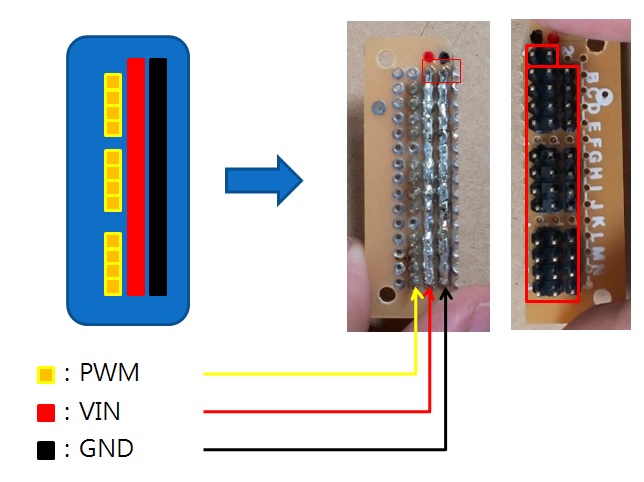Making an Electronic Expansion Board
If the main control board you are using is 86Duino Zero, in order to quickly and neatly connect multiple servos to 86Duino Zero, it is strongly recommended to manually make an electronic expansion board. It consists of 3 3×4 DuPont pins and 1 1×2 DuPont pin. Each 3×4 pin can be plugged into 4 servos, and 3 groups can be plugged into a total of 12 servos. A group of 3×4 DuPont pins has:
1. Power line (VIN)
2. Ground line (GND)
3. Signal line (PWM)
The power (red line) is shared by each servo, and the ground line (black line) is also shared by each servo. You can use a soldering iron tool to solder these pins into two parallel straight lines, as shown in the red and black double lines in the figure below. The orange wire is the signal wire, which we will use Dupont wires (a total of 12 wires) to connect to the main control board pins. Do not solder them in a row like the red and black double wires, just add some tin to fix them. The last 1×2 pin is the source of power and ground wire, and it can be soldered above the extension of the red and black double wires. Please remember: there must be no solder connection between the red and black double wires, and the double wires must be made into two "completely separated" parallel wires, otherwise it will form a "short circuit" phenomenon in circuit science, which may burn your servo and damage your battery in serious cases. Be sure to check again and again. The left side of the picture below is the wiring diagram, the middle is the bottom view of the finished product, and the right side is the top view of the finished product: 
Please refer to the above picture to make one. Since the soldering iron tool (including solder) is required in the process, the temperature of the soldering iron tip is very high. Children must be accompanied by their parents when using it to avoid accidental burns during operation.
Assemble a PrintBot Crab
The text of the 86Duino reference is licensed under a Creative Commons Attribution-ShareAlike 3.0 License. Code samples in the reference are released into the public domain.
